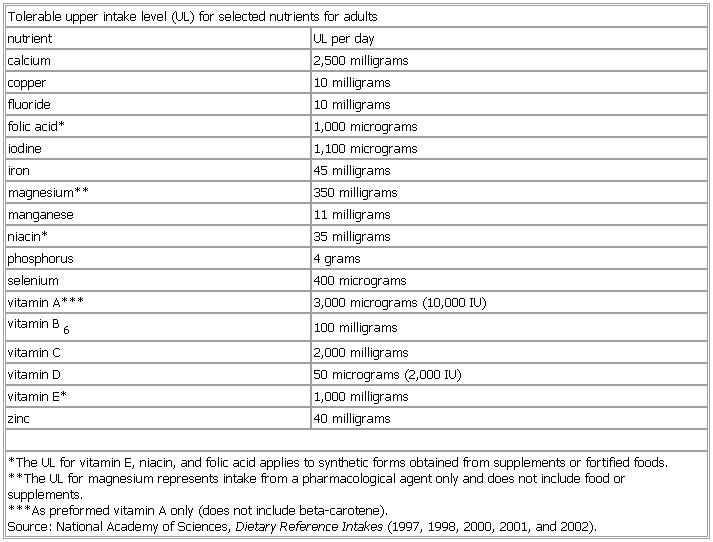Tolerable upper intake level for selected nutrients for adults
- Tolerable upper intake level for selected nutrients for adults
-
Tolerable upper intake level (
UL)
for selected nutrients for adults
nutrient UL per day
calcium 2,500 milligrams
copper 10 milligrams
fluoride 10 milligrams
folic acid* 1,000 micrograms
iodine 1,100 micrograms
iron 45 milligrams
magnesium** 350 milligrams
manganese 11 milligrams
niacin* 35 milligrams
phosphorus 4 grams
selenium 400 micrograms
vitamin A*** 3,000 micrograms (10,000 IU)
vitamin B6 100 milligrams
vitamin C 2,000 milligrams
vitamin D 50 micrograms (2,000 IU)
vitamin E* 1,000 milligrams
zinc 40 milligrams
*The UL for vitamin E, niacin, and folic acid applies to synthetic forms obtained from supplements or fortified foods.
**The UL for magnesium represents intake from a pharmacological agent only and does not include food or supplements.
***As preformed vitamin A only (does not include beta-carotene).
See as table:
* * *
Universalium.
2010.
Look at other dictionaries:
nutrition, human — Introduction process by which substances in food are transformed into body tissues and provide energy for the full range of physical and mental activities that make up human life. The study of human nutrition is interdisciplinary in… … Universalium
nutritional disease — Introduction any of the nutrient related diseases and conditions that cause illness in humans. They may include deficiencies or excesses in the diet, obesity and eating disorders, and chronic diseases such as cardiovascular disease,… … Universalium
Vitamin C — This article is about ascorbic acid as a nutrient; for its chemical properties, see the article ascorbic acid; for other uses, see the disambiguation page. Vitamin C … Wikipedia
Folic acid — Folic acid … Wikipedia
Vitamin C megadosage — Chemical structure of vitamin C Chemical … Wikipedia

